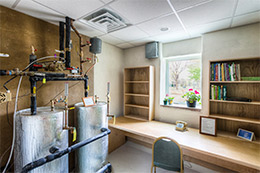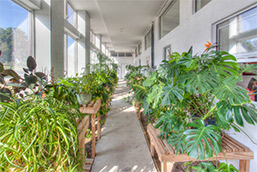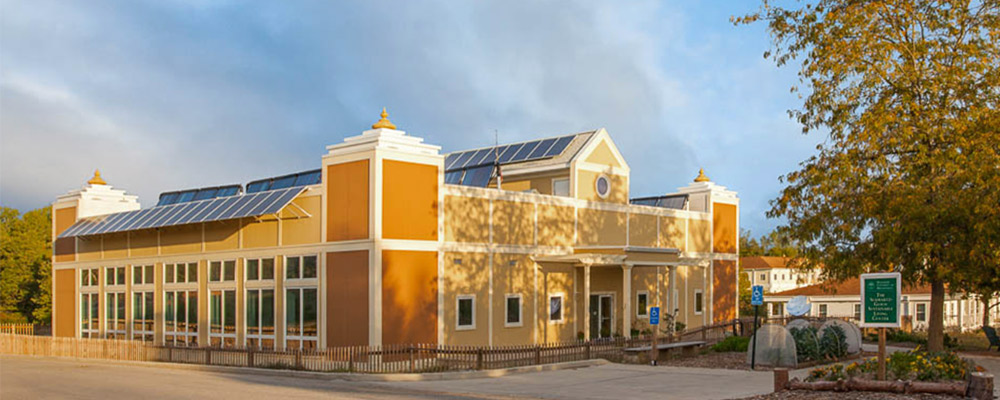Iowa is notorious for its cold winters. During January and February—when temperatures often drop below zero—even conventional buildings and homes can have trouble keeping up with the climate. Enter Maharishi University of Management’s Schwartz-Guich Sustainable Living Center, one of the highest-performing zero-energy buildings in the United States.
Located in Fairfield, Iowa on the Maharishi University of Management (MUM) campus, the Sustainable Living Center uses wind and solar energy, along with innovative design elements, to reach complete carbon-neutrality.
“There are very few buildings in the world that can say they are net-zero, and most of those are in climates that are far less demanding than ours. That’s what makes [our] building so remarkable energy-wise,” says Dr. David Fisher, chairperson of the university’s Sustainable Living department.
Net Zero Energy
The Sustainable Living Center has recently caught the attention of Getting to Zero, an organization that keeps track of ultra-efficient buildings and their energy usage. Net zero energy is a sought-after goal for many buildings in the world that rely on exceptional energy conservation and on-site renewable generation to meet all of their heating, cooling, and electricity needs.

The hot-water heating system uses solar and geothermal heat to keep the building warm.
Getting to Zero said that the Center is among the highest-performing buildings they had encountered, especially given Iowa’s harsh climate. According to their calculations, the Sustainable Living Center’s net Energy Use Intensity (EUI) was –0.5 in 2015, indicating that the building actually produced 5 percent more energy than it used.
The year 2015 was the only year consistent data tracking was available at the Sustainable Living Center, but according to estimates, the building was even more efficient in previous years, producing as much as 30 percent more energy than it used.
Renewable Energy Sources
The building’s electricity comes from two sources: solar photovoltaic panels and a wind turbine. The heating is provided by solar hot water heaters. The heating and cooling are also supplemented by geothermal tubing.
The building materials themselves are predominantly local, from the whole aspen trees that support the Center to the 25,000 student-made earth blocks that provide thermal mass. The roof is a rain catchment system; the entire south wall is a greenhouse that provides solar heating as well as space for student projects.
A Living, Growing Building
The building is currently “grid-tied,” which means it feeds the excess capacity back to the MUM electrical grid and draws from it in times of insufficient production. The overall energy consumption of the building, however, is negative.

The center features many energy-saving features, such as a passive solar sun room on the south side.
Even though the building is already receiving recognition for its impressive energy efficiency, the university is still looking for ways to make it even more sustainable. Ideal Energy Inc., the local, MUM-alumni-owned company that installed the building’s photovoltaic solar panels, is currently researching the feasibility of a battery-supported, off-the-grid system.
“It is a living and growing demonstration building,” says Dr. Fisher. “I believe we could do even better.”


Comments
YOU MAY ALSO LIKE
Education
New Medical School Program: Integrative Medicine Joins East & West
Dreaming of becoming a doctor who has mastered the best of both Eastern and Western medical knowledge? Here’s your chance to do so quickly and without stress.
Creativity & the Arts
Lawrence Sheaff: An Artist Giving Back
Lawrence Sheaff worked with Maharishi Mahesh Yogi as a visual artist for 18 years. When he returned to his own work he wanted to combine the two things he loved most: Vedic Science and painting.
Creativity & the Arts
Architect Bing Thom Speaks on TM and Creativity
Bing Thom is an award-winning architect and recipient of Canada’s celebrated Golden Jubilee Medal, honoring Canadians who made a significant contribution to the nation. TM supports his work.
Vedic Knowledge
Creating a Home Where We Feel Whole
“The impressive results we have seen for homeowners include greater happiness, better health, and increased financial success.” —Jonathan Lipman, A.I.A.